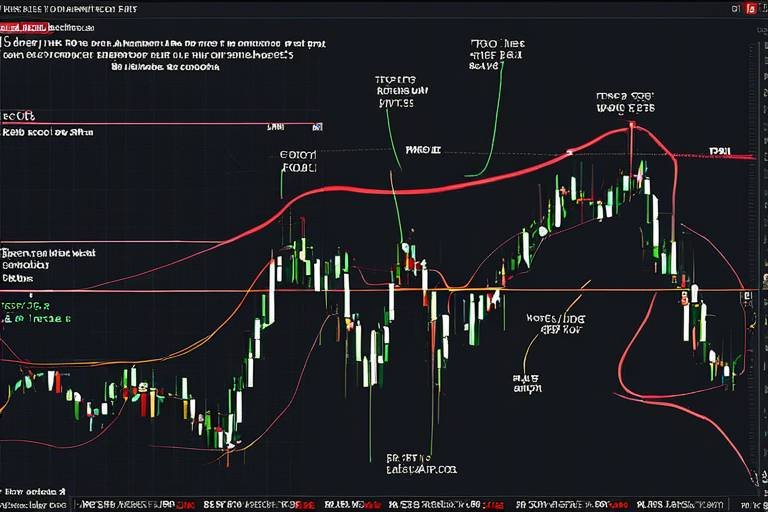Creating a Diversified Crypto Portfolio - Strategies and Tips
In the ever-evolving world of cryptocurrency, the phrase "don't put all your eggs in one basket" rings truer than ever. With the market's unpredictable nature, creating a diversified crypto portfolio isn't just a smart move; it's essential for anyone serious about investing. A well-rounded portfolio can help you ride the waves of market volatility while maximizing your potential returns. But how do you go about building one? Let’s dive into the strategies and tips that can help you navigate this thrilling yet tumultuous landscape.
Before you start throwing your hard-earned cash into various coins, it's crucial to understand what cryptocurrency is all about. At its core, cryptocurrency is a form of digital or virtual currency that uses cryptography for security. Most cryptocurrencies operate on a technology called blockchain, which is a decentralized ledger that records all transactions across a network of computers. This technology not only ensures transparency but also enhances security, making it a game-changer in the financial world.
There are thousands of cryptocurrencies available today, each with unique features and purposes. From Bitcoin, the original cryptocurrency, to Ethereum, which introduced smart contracts, understanding the different types of cryptocurrencies and their market dynamics is vital for making informed investment decisions. The crypto market is highly volatile, with prices that can swing dramatically in a short period. This volatility can be both an opportunity and a risk, which is why a diversified portfolio is your best defense.
Diversification is like a safety net in the circus of cryptocurrency investing. By spreading your investments across various assets, you minimize the risks associated with any single investment. Imagine you have a portfolio made up entirely of one cryptocurrency. If that coin plummets, so does your entire investment. However, if you diversify and invest in multiple cryptocurrencies, the impact of one failing investment can be cushioned by others that may be thriving.
In the unpredictable crypto landscape, diversification is not just a strategy; it's a necessity. It allows you to take advantage of different market trends and reduces the overall risk of your portfolio. Remember, the goal is to enhance returns while managing risks, and diversification is a powerful tool to achieve that.
Now that you understand the importance of diversification, how do you choose the right cryptocurrencies to include in your portfolio? The answer lies in thorough research and analysis. Here are some factors to consider:
Market capitalization, or market cap, is a key metric that helps you gauge the size and stability of a cryptocurrency. It’s calculated by multiplying the current price of the cryptocurrency by its total circulating supply. Generally, cryptocurrencies can be categorized into three groups based on their market cap:
| Market Cap Category | Description |
|---|---|
| Large Cap | Stable and established cryptocurrencies like Bitcoin and Ethereum. |
| Mid Cap | Moderately sized cryptocurrencies that have growth potential. |
| Small Cap | Higher risk but potentially high reward cryptocurrencies. |
Understanding these categories can aid in making informed investment decisions. Large-cap coins tend to be more stable, while small-cap coins can offer significant growth opportunities but come with higher risks.
When evaluating a cryptocurrency, it's essential to consider its underlying technology and real-world application. Ask yourself: What problem does this cryptocurrency solve? How does its technology stand out from the competition? A cryptocurrency with a solid use case and innovative technology is more likely to succeed in the long run.
For instance, Ethereum's smart contract functionality allows developers to create decentralized applications, which adds immense value to its ecosystem. In contrast, a coin without a clear purpose may struggle to gain traction. Always do your homework and assess the technology behind the coins you’re considering for your portfolio.
Effective risk management is crucial in the world of crypto investing. Here are some strategies to help protect your investments from the inevitable market volatility:
Establishing clear investment limits can help prevent emotional decision-making. It's easy to get swept up in the excitement of a bullish market or panic during a downturn. By setting limits that align with your financial goals, you can make more rational decisions without being swayed by market emotions.
Dollar-cost averaging is a strategy that involves investing a fixed amount of money at regular intervals, regardless of the cryptocurrency's price. This approach can help reduce the impact of market fluctuations, as you’ll be buying more coins when prices are low and fewer when prices are high. Over time, this strategy can lead to lower average costs and improved returns.
Continuous monitoring and rebalancing are vital for maintaining a diversified portfolio. The crypto market is dynamic, and what works today may not work tomorrow. Regularly reviewing your investments allows you to make necessary adjustments and stay aligned with your financial goals. Consider setting a schedule for portfolio reviews—perhaps quarterly or bi-annually—to ensure you're on track.
- What is the best way to start investing in cryptocurrency? Start by educating yourself about the market and choosing a reputable exchange to buy and trade cryptocurrencies.
- How much should I invest in cryptocurrency? Only invest what you can afford to lose, and consider diversifying across different assets to manage risk.
- How often should I rebalance my portfolio? It's advisable to review your portfolio at least once every few months or whenever there are significant market changes.
- What are the risks associated with cryptocurrency investing? The main risks include market volatility, regulatory changes, and security concerns. Always do thorough research before investing.

Understanding Cryptocurrency Basics
Before you dive headfirst into the world of cryptocurrencies, it's essential to understand the basics. Think of cryptocurrency as digital money that operates on a technology called blockchain. This technology is like a digital ledger that records all transactions across a network of computers. Unlike traditional currencies issued by governments, cryptocurrencies are decentralized, meaning no single entity controls them. This decentralization is what gives cryptocurrencies their appeal, but it also introduces certain risks and complexities.
There are thousands of cryptocurrencies available today, but the most popular ones include Bitcoin, Ethereum, and Ripple. Each of these coins has unique features and serves different purposes. For instance, Bitcoin is often referred to as digital gold due to its limited supply, while Ethereum is known for its smart contract functionality, enabling developers to create decentralized applications.
Understanding market dynamics is another crucial aspect of cryptocurrency. The market is notoriously volatile, with prices that can swing dramatically within a short period. This volatility can be thrilling for investors, but it's important to approach it with caution. Factors influencing the market include technological advancements, regulatory news, and overall market sentiment. For instance, when a major country announces favorable regulations for cryptocurrencies, you might see a surge in prices, while negative news can lead to a sharp decline.
To give you a clearer picture of the crypto landscape, here's a quick overview of some key terms you should familiarize yourself with:
- Altcoin: Any cryptocurrency other than Bitcoin.
- Wallet: A digital tool used to store, send, and receive cryptocurrencies.
- Exchange: A platform where you can buy, sell, or trade cryptocurrencies.
- Mining: The process of validating transactions and adding them to the blockchain, often rewarded with new coins.
In summary, understanding the basics of cryptocurrency involves grasping the underlying technology, knowing the different types of coins, and being aware of market dynamics. With this foundational knowledge, you’ll be better equipped to navigate the exciting yet unpredictable world of crypto investing.

Importance of Diversification
When it comes to investing in cryptocurrencies, the phrase "don't put all your eggs in one basket" couldn't be more applicable. The crypto market is notoriously volatile, with prices that can swing dramatically in a matter of hours. This unpredictability makes it essential to embrace diversification as a core strategy in your investment approach. By spreading your investments across a variety of cryptocurrencies, you can reduce the overall risk associated with your portfolio.
Imagine you’re at a buffet. If you only fill your plate with one dish, you might miss out on a delicious dessert or a savory side that could have enhanced your meal. Similarly, investing in a single cryptocurrency can lead to missed opportunities and increased risk. Diversification allows you to enjoy a broader range of potential returns while cushioning the blow if one of your investments performs poorly.
Moreover, diversification can help you capitalize on different market trends. For instance, while Bitcoin might be experiencing a downturn, other altcoins could be surging due to unique developments or market demands. By having a mix of assets, you position yourself to benefit from various trends and innovations within the crypto space. Here are a few reasons why diversification is crucial:
- Risk Mitigation: By holding a variety of cryptocurrencies, the impact of a poor-performing asset is lessened, as gains from other investments can offset losses.
- Exposure to Opportunities: The crypto landscape is vast, with thousands of coins and tokens available. Diversification allows you to tap into emerging projects that may offer significant upside potential.
- Stability: A diversified portfolio can provide more stable returns over time, as different assets may react differently to market changes.
However, it's essential to strike a balance. Over-diversification can lead to a diluted portfolio where the performance of individual assets becomes negligible. The key is to choose a manageable number of cryptocurrencies that you believe in and that align with your investment strategy. A well-thought-out diversification strategy not only helps mitigate risks but also positions you for potential growth as the market evolves.
In conclusion, the importance of diversification in cryptocurrency investing cannot be overstated. By spreading your investments wisely, you can enhance your potential for returns while managing risks effectively. Remember, the crypto market is a wild ride, and having a diversified portfolio is like having a safety net that allows you to enjoy the journey without the constant fear of falling.
What is diversification in cryptocurrency?
Diversification in cryptocurrency refers to the practice of spreading investments across multiple cryptocurrencies to reduce risk and increase potential returns.
Why is diversification important?
Diversification is important because it helps mitigate risks associated with the volatility of the crypto market. By investing in various assets, you can cushion losses from poorly performing investments.
How many cryptocurrencies should I hold in my portfolio?
While there is no one-size-fits-all answer, a good rule of thumb is to hold between 5 to 15 different cryptocurrencies. This range allows for adequate diversification without becoming overwhelming.
Can I over-diversify my portfolio?
Yes, over-diversification can dilute your portfolio's performance. It's essential to find a balance that allows you to benefit from various assets without spreading yourself too thin.

Choosing the Right Cryptocurrencies
When it comes to building a successful cryptocurrency portfolio, choosing the right cryptocurrencies is akin to selecting the perfect ingredients for a gourmet meal. You wouldn't just throw random ingredients into a pot and hope for the best, right? Similarly, investing in cryptocurrencies requires careful consideration and research to ensure you're not just chasing the latest trend but are instead making informed decisions that align with your financial goals.
First and foremost, you need to dive deep into research. This means looking beyond the flashy headlines and understanding the core fundamentals of each cryptocurrency. What is its purpose? Who is behind it? What problem does it solve? These questions are vital in determining whether a cryptocurrency is worth your investment. For instance, Bitcoin might be the king of cryptocurrencies, but that doesn't mean every new altcoin is a worthy contender. It's essential to evaluate each asset on its own merits.
One of the first factors to consider is market capitalization. Market cap gives you a snapshot of a cryptocurrency's size and stability. It's calculated by multiplying the current price of the coin by its total circulating supply. A higher market cap often indicates a more established and stable asset, while lower market cap coins can offer higher potential returns but come with increased risk. Here's a quick comparison:
| Cryptocurrency | Market Cap (in billions) | Stability |
|---|---|---|
| Bitcoin (BTC) | $800 | High |
| Ethereum (ETH) | $400 | High |
| Dogecoin (DOGE) | $10 | Medium |
| Shiba Inu (SHIB) | $5 | Low |
Next, you should assess the technology and use case of each cryptocurrency. Is the technology behind the coin robust? Does it have a real-world application? For instance, Ethereum is not just a cryptocurrency; it also serves as a platform for decentralized applications (dApps). This added utility can significantly enhance its value proposition. Conversely, if a coin lacks a clear use case or technological backing, it might be wise to steer clear.
Moreover, keeping an eye on the development team and community support can provide insights into the longevity and reliability of a cryptocurrency. A passionate and active community can drive innovation and adoption, while a stagnant project can be a red flag. Look for projects that are transparent about their development and engage with their community regularly.
Finally, don’t forget to consider the market trends and sentiment. The crypto market is notoriously volatile, and understanding the broader market dynamics can help you make better investment decisions. Tools like social media sentiment analysis and market news can provide valuable insights into how a cryptocurrency is perceived in the market. Just like a weather forecast can guide your outdoor plans, market sentiment can guide your investment strategies.
In conclusion, choosing the right cryptocurrencies is a blend of art and science. By conducting thorough research, understanding market capitalization, evaluating technology, and keeping an eye on community engagement, you can create a well-rounded portfolio that not only stands the test of time but also maximizes your potential returns. Remember, in the world of crypto, knowledge is power!
- What is market capitalization? Market capitalization is the total value of a cryptocurrency, calculated by multiplying its current price by the total circulating supply.
- Why is diversification important in crypto investing? Diversification helps spread risk across various assets, reducing the impact of any single investment's poor performance.
- How often should I rebalance my crypto portfolio? It's generally recommended to review and rebalance your portfolio at least quarterly or whenever there's a significant market shift.

Market Capitalization
Market capitalization, often referred to as market cap, is a key metric that investors should consider when evaluating cryptocurrencies. It represents the total value of a cryptocurrency and is calculated by multiplying the current price of a single coin by the total number of coins in circulation. Understanding market capitalization is crucial because it provides insight into the size and stability of a cryptocurrency, helping you make informed investment decisions.
When you think about market cap, it's like looking at the overall health of a company. Just as a larger company with a high market cap is often seen as more stable than a smaller one, the same principle applies to cryptocurrencies. Here’s a breakdown of how market cap can influence your investment strategy:
| Market Cap Range | Description | Investment Implications |
|---|---|---|
| Large Cap ($10 billion and above) | These cryptocurrencies are typically more stable and less volatile. | Lower risk, suitable for conservative investors. |
| Mid Cap ($1 billion - $10 billion) | These coins may offer a balance of risk and reward, often showing significant growth potential. | Moderate risk, good for those seeking growth. |
| Small Cap (Below $1 billion) | These cryptocurrencies can be highly volatile and risky but may offer the highest potential returns. | High risk, suitable for aggressive investors. |
By categorizing cryptocurrencies into these segments, you can better assess your risk tolerance and investment goals. For instance, if you're looking for stability, investing in large-cap cryptocurrencies like Bitcoin or Ethereum might be ideal. On the other hand, if you’re feeling adventurous and want to chase high returns, you might explore small-cap options.
However, it's essential to remember that market cap is not the only factor to consider. While a high market cap can indicate stability, it doesn't guarantee future performance. Market dynamics, regulatory news, and technological advancements can all sway a cryptocurrency's value. Therefore, it's wise to combine market cap analysis with other factors such as technology, use case, and market trends.
In summary, understanding market capitalization is a fundamental part of building a diversified cryptocurrency portfolio. It allows you to gauge the relative strength of different cryptocurrencies and can guide you in making strategic investment choices. Always keep in mind that while market cap provides valuable insights, a comprehensive approach that considers multiple factors will lead to more informed decisions in the ever-evolving world of cryptocurrency.
- What is market capitalization in cryptocurrency?
Market capitalization is the total value of a cryptocurrency, calculated by multiplying its current price by the total number of coins in circulation.
- Why is market cap important?
Market cap helps investors assess the size and stability of a cryptocurrency, influencing investment decisions and risk management strategies.
- How should I use market cap when investing?
Consider the market cap category (large, mid, or small cap) to align your investments with your risk tolerance and financial goals.

Technology and Use Case
When it comes to investing in cryptocurrencies, understanding the technology behind each coin and its real-world use case is paramount. Just like choosing a car based on its performance, reliability, and features, selecting a cryptocurrency requires a keen eye for its underlying technology and practical applications. This helps you gauge whether a coin is simply a trend or if it has the potential for long-term growth.
At the heart of most cryptocurrencies is blockchain technology, a decentralized ledger that records all transactions across a network of computers. This technology not only ensures transparency but also enhances security, making it a vital component for any cryptocurrency. For instance, Bitcoin operates on a proof-of-work mechanism, which requires significant computational power to validate transactions, ensuring that the network remains secure. On the other hand, Ethereum utilizes a more flexible platform that allows developers to create smart contracts—self-executing contracts with the terms of the agreement directly written into code. This difference illustrates how varying technologies can cater to different use cases.
When evaluating a cryptocurrency, consider the following factors:
- Real-World Application: Does the cryptocurrency solve a real problem? For example, Ripple aims to facilitate cross-border payments, which is a significant pain point in the financial industry.
- Community Support: A strong community can drive the development and adoption of a cryptocurrency. Look for active forums, social media presence, and developer engagement.
- Partnerships: Check if the cryptocurrency has partnerships with established companies or organizations, as this can enhance its credibility and adoption.
Moreover, consider how the technology can adapt to future trends. Cryptocurrencies that can evolve with technological advancements are likely to remain relevant. For example, the rise of decentralized finance (DeFi) has led to the development of numerous coins that facilitate lending, borrowing, and trading without intermediaries. Understanding how a cryptocurrency fits into the broader financial ecosystem can significantly influence your investment decision.
In conclusion, the technology and use case of a cryptocurrency are not just buzzwords; they are the bedrock of its potential success. By doing your homework and digging deep into these aspects, you can make informed decisions that align with your investment goals. Remember, investing in crypto isn't just about following the crowd; it's about understanding what makes each coin unique and valuable.
- What is the best cryptocurrency to invest in? The best cryptocurrency varies based on individual goals and risk tolerance. Researching technology and use cases is essential.
- How do I know if a cryptocurrency is legitimate? Look for transparent teams, active communities, and real-world applications. Always do your due diligence.
- Can I lose all my money in cryptocurrency? Yes, investing in cryptocurrencies carries risks. It's crucial to diversify and not invest more than you can afford to lose.

Risk Management Strategies
When it comes to investing in cryptocurrency, one of the most critical aspects to consider is risk management. The crypto market is notorious for its volatility, and without a solid strategy in place, you could find yourself facing significant losses. Think of risk management as your financial safety net—it's there to catch you when the market takes a nosedive. So, how do you effectively manage risk while navigating this unpredictable landscape? Let’s explore some essential strategies that can help safeguard your investments.
One of the first steps in effective risk management is setting investment limits. This means defining how much of your capital you are willing to invest in cryptocurrencies and, more importantly, how much you can afford to lose. By establishing clear limits, you can prevent emotional decision-making that often leads to poor investment choices. For instance, if you decide that you will only invest 10% of your total portfolio in crypto, you’ll have a clear guideline to follow, helping you avoid the temptation to go all-in during a market surge or panic sell during a downturn.
Another powerful strategy is dollar-cost averaging. This approach involves investing a fixed amount of money at regular intervals, regardless of the cryptocurrency's price. Imagine you’re filling a tank with gas—sometimes the price is high, and sometimes it’s low. By consistently buying in, you can average out your costs over time, reducing the impact of market fluctuations. This method not only helps mitigate risk but also allows you to build your portfolio gradually, making it less likely that you will experience a significant loss from a single investment.
Additionally, diversifying your investments can significantly enhance your risk management strategy. Instead of putting all your eggs in one basket, consider allocating your capital across a variety of cryptocurrencies. This could include established coins like Bitcoin and Ethereum, as well as smaller altcoins that show potential. By spreading your investments, you can reduce the overall risk, as the performance of one asset might offset the losses of another. Here’s a simple example of how diversification can work:
| Cryptocurrency | Investment Amount | Potential Risk |
|---|---|---|
| Bitcoin | $1,000 | Moderate |
| Ethereum | $500 | Moderate |
| Altcoin A | $300 | High |
| Altcoin B | $200 | Very High |
In this example, if Bitcoin and Ethereum perform well, they can cushion the potential losses from the more volatile altcoins. This illustrates the importance of having a mix of assets in your portfolio to manage risk effectively.
Lastly, it’s crucial to stay informed and continuously monitor your investments. The crypto landscape is ever-evolving, and market conditions can shift rapidly. Regularly reviewing your portfolio allows you to make timely adjustments based on market trends, news, and your personal financial situation. This proactive approach can help you respond to market changes before they significantly impact your investments.
In conclusion, managing risk in cryptocurrency investing is not just about avoiding losses; it's about creating a sustainable investment strategy that allows you to weather the storms of market volatility. By setting investment limits, using dollar-cost averaging, diversifying your portfolio, and staying informed, you can significantly enhance your chances of success in this exciting yet unpredictable market.
Frequently Asked Questions
- What is risk management in cryptocurrency? Risk management in cryptocurrency involves strategies to minimize potential losses while maximizing potential gains in a highly volatile market.
- How much of my portfolio should I invest in cryptocurrency? It varies per individual, but many experts recommend limiting crypto investments to no more than 10-20% of your overall portfolio to manage risk effectively.
- What is dollar-cost averaging? Dollar-cost averaging is an investment strategy where you invest a fixed amount of money at regular intervals, which helps reduce the impact of market volatility.
- Why is diversification important? Diversification spreads risk across different assets, reducing the impact of any single investment's poor performance on your overall portfolio.

Setting Investment Limits
When it comes to investing in cryptocurrencies, one of the most crucial yet often overlooked strategies is . Imagine you're at a buffet, and everything looks delicious. You want to try everything, but if you pile your plate too high, you might end up overwhelmed or sick. The same principle applies in the world of crypto. Without clear limits, you risk making impulsive decisions that could lead to significant losses.
Establishing investment limits is not just about protecting your capital; it’s also about maintaining a healthy mindset. The crypto market is notorious for its volatility, and emotions can run high when prices fluctuate. By setting boundaries, you create a framework that helps you stay disciplined and focused on your long-term goals. So, how do you go about setting these limits?
First, consider your overall financial situation. Ask yourself questions like:
- What is my total investment budget?
- How much am I willing to risk in the crypto market?
- What are my financial goals, and how does crypto fit into them?
Once you have a clear understanding of your financial landscape, you can establish specific limits for each cryptocurrency in your portfolio. For instance, you might decide that no single investment should exceed 10% of your total crypto budget. This approach not only diversifies your risk but also allows you to spread your investments across multiple assets, thereby increasing your chances of hitting a winner.
Another effective method is to set a stop-loss limit. This is a predetermined price point at which you will sell a cryptocurrency to prevent further losses. For example, if you buy a coin at $100, you might set a stop-loss at $80. This way, if the market takes a downturn, you automatically cut your losses without having to make a last-minute decision fueled by panic.
In addition to setting limits for individual investments, it’s also wise to establish a total loss limit for your entire portfolio. This means deciding in advance how much you are willing to lose before you step back and reassess your strategy. For instance, if your total investment is $1,000, you might set a total loss limit of 20%, meaning you would reevaluate your investments if your portfolio drops to $800. This disciplined approach can help you avoid the temptation to hold onto a losing investment in hopes that it will rebound.
Lastly, remember that your investment limits should not be set in stone. The crypto market is dynamic, and so should be your strategy. Regularly reviewing and adjusting your limits based on market conditions and your personal financial situation is essential. This flexibility can empower you to make informed decisions while minimizing the emotional rollercoaster that often accompanies crypto trading.
In summary, setting investment limits is a fundamental strategy for anyone looking to navigate the unpredictable waters of cryptocurrency. By establishing clear boundaries, you can protect your capital, maintain emotional stability, and ultimately enhance your chances of achieving your financial goals. So, take the time to define your limits today; your future self will thank you!
- What is the best way to set investment limits? Start by assessing your financial situation and determining how much you can afford to invest without jeopardizing your financial stability.
- Should I set stop-loss limits for all my investments? It's advisable to set stop-loss limits for all significant investments to protect against major losses.
- How often should I reevaluate my investment limits? Regularly review your limits, especially after significant market movements or changes in your personal financial situation.

Dollar-Cost Averaging
Dollar-cost averaging (DCA) is a powerful investment strategy that can serve as your safety net in the unpredictable world of cryptocurrency. Imagine you're at a carnival, and instead of betting all your money on a single game, you decide to play several times, spreading your bets over the day. This approach minimizes the risk of losing everything in one go, and that's precisely what DCA does for your crypto investments.
Essentially, dollar-cost averaging involves investing a fixed amount of money into a cryptocurrency at regular intervals, regardless of its price. For example, if you decide to invest $100 every month in Bitcoin, you'll purchase more coins when prices are low and fewer when they're high. Over time, this strategy helps to smooth out the effects of price volatility, allowing you to buy at an average price rather than trying to time the market perfectly, which is notoriously difficult.
One of the significant advantages of DCA is that it removes the emotional component from investing. When prices are soaring, it’s easy to get caught up in the excitement and invest more than you should. Conversely, during a market dip, fear can lead to hesitance or panic-selling. By committing to a fixed investment amount, you can stay disciplined and avoid making impulsive decisions driven by market emotions.
To illustrate how dollar-cost averaging can work in practice, consider the following hypothetical scenario:
| Month | Investment Amount | Bitcoin Price | Bitcoin Purchased |
|---|---|---|---|
| 1 | $100 | $10,000 | 0.01 BTC |
| 2 | $100 | $8,000 | 0.0125 BTC |
| 3 | $100 | $12,000 | 0.0083 BTC |
| 4 | $100 | $9,000 | 0.0111 BTC |
In this example, by investing $100 each month, you accumulate a varying amount of Bitcoin depending on the price at the time of purchase. Over four months, you’ve invested a total of $400 and purchased a total of 0.0419 BTC. If you had tried to time the market, you might have hesitated during the price dips or jumped in at the peak, potentially leading to a less favorable average cost.
Moreover, DCA can be particularly beneficial for new investors who may feel overwhelmed by the complexities of the crypto market. It allows you to enter the market gradually, giving you time to learn and adapt without the pressure of making large, immediate investments. As you grow more comfortable and knowledgeable, you can adjust your strategy accordingly.
In conclusion, dollar-cost averaging is not just a strategy; it’s a mindset. It encourages patience and discipline, two critical traits for navigating the volatile waters of cryptocurrency investing. By committing to regular investments, you can build your portfolio steadily while reducing the risks associated with price fluctuations. So, why not give it a shot? After all, every little bit counts, and in the world of crypto, consistency can be your best friend.
- What is dollar-cost averaging? - It is an investment strategy that involves investing a fixed amount of money at regular intervals, regardless of the asset's price.
- How does DCA help in cryptocurrency investing? - DCA reduces the emotional impact of investing and mitigates the risks associated with market volatility.
- Can I use DCA for other investments? - Yes, DCA can be applied to various types of investments, including stocks and mutual funds.
- Is dollar-cost averaging guaranteed to make money? - While it can help manage risk, there's no guarantee of profits, as all investments carry risks.

Monitoring and Rebalancing Your Portfolio
Once you've crafted your diversified cryptocurrency portfolio, the journey doesn't end there; in fact, it’s just the beginning! Monitoring and rebalancing your portfolio are essential practices to ensure that your investments remain aligned with your financial goals and risk tolerance. Think of it like tending to a garden – regular maintenance is key to ensuring that everything grows as it should. If you neglect your portfolio, you might find that some assets have flourished while others have withered away, potentially throwing your investment strategy off balance.
Monitoring your portfolio involves keeping an eye on the performance of your cryptocurrencies and the overall market trends. It's important to regularly check how your investments are performing against your expectations. You can use various tools and platforms that provide real-time data and analytics about your holdings. For instance, consider setting up alerts for significant price movements or market news that could impact your investments. Staying informed will empower you to make timely decisions, whether that means buying, selling, or holding onto your assets.
Now, let’s talk about rebalancing. This is the process of adjusting your portfolio to maintain your desired level of asset allocation. Over time, certain cryptocurrencies may outperform others, leading to an imbalance in your portfolio. For example, if Bitcoin skyrockets while your altcoins lag behind, you might find that Bitcoin now represents a larger percentage of your portfolio than you initially intended. Rebalancing helps you sell off some of the gains from your winners and reinvest them into underperforming assets, keeping your risk profile in check.
There are a few strategies you can adopt when it comes to rebalancing:
- Time-Based Rebalancing: This involves setting a specific time frame (e.g., monthly, quarterly, or annually) to review and adjust your portfolio.
- Threshold-Based Rebalancing: Here, you set specific thresholds (e.g., 5% or 10%) for when to rebalance. If any asset class exceeds this threshold, it's time to make adjustments.
- Combination of Both: You can also adopt a hybrid approach, where you monitor your portfolio regularly but only rebalance when certain thresholds are met.
To make the process easier, consider using portfolio management tools that can automatically track your investments and alert you when it’s time to rebalance. These tools often provide insights into your portfolio's performance, helping you make informed decisions without having to dive deep into the data yourself.
In conclusion, monitoring and rebalancing your cryptocurrency portfolio is not just a good practice; it's essential for long-term success. By staying vigilant and proactive, you can adapt to market changes, mitigate risks, and keep your investment strategy on track. Remember, even the most seasoned investors continuously refine their portfolios to align with their financial objectives. So, roll up your sleeves and get ready to nurture your crypto garden!
1. How often should I monitor my cryptocurrency portfolio?
It's advisable to monitor your portfolio regularly, at least once a week. However, during times of high volatility, daily checks may be beneficial.
2. What is the best strategy for rebalancing my portfolio?
The best strategy depends on your investment goals and risk tolerance. Time-based rebalancing is simpler, while threshold-based may be more responsive to market changes.
3. Can I automate the monitoring and rebalancing process?
Yes! Many portfolio management tools offer automation features that can help you track performance and even execute trades based on your predefined criteria.
4. What should I do if the market is extremely volatile?
In volatile markets, it’s crucial to stick to your strategy and avoid making impulsive decisions. Regularly review your portfolio and be ready to adjust your rebalancing thresholds if needed.
Frequently Asked Questions
-
What is a diversified crypto portfolio?
A diversified crypto portfolio is an investment strategy that involves spreading your investments across various cryptocurrencies rather than putting all your money into one. This approach helps to minimize risk and can enhance potential returns, especially in the highly volatile crypto market.
-
Why is diversification important in cryptocurrency investing?
Diversification is crucial because the cryptocurrency market is unpredictable and can experience significant price swings. By diversifying your investments, you reduce the impact of a poor-performing asset on your overall portfolio. It's like not putting all your eggs in one basket; if one egg cracks, you still have others intact!
-
How do I choose the right cryptocurrencies for my portfolio?
Choosing the right cryptocurrencies involves thorough research and analysis. Consider factors such as market capitalization, technology, use case, and the team behind the project. Look for cryptocurrencies that have a solid foundation and real-world applications, as these are more likely to succeed in the long run.
-
What is market capitalization, and why does it matter?
Market capitalization refers to the total value of a cryptocurrency, calculated by multiplying its current price by the total supply of coins. It helps investors gauge the size and stability of a cryptocurrency. Generally, larger market cap coins are considered more stable, while smaller caps can offer higher growth potential but come with increased risk.
-
What are some effective risk management strategies in crypto investing?
Some effective risk management strategies include setting clear investment limits, using dollar-cost averaging, and regularly monitoring your portfolio. By establishing limits, you can avoid emotional decisions, while dollar-cost averaging allows you to invest a fixed amount regularly, reducing the impact of market volatility.
-
What is dollar-cost averaging, and how does it work?
Dollar-cost averaging is an investment strategy where you invest a fixed amount of money at regular intervals, regardless of the asset's price. This approach can help mitigate the effects of market fluctuations, as you buy more coins when prices are low and fewer when prices are high, ultimately averaging out your purchase price over time.
-
How often should I monitor and rebalance my crypto portfolio?
It's advisable to monitor your portfolio regularly, at least once a month. Rebalancing should be done whenever your asset allocation deviates significantly from your target. This ensures that you maintain your desired level of risk and can adapt to changing market conditions effectively.



















